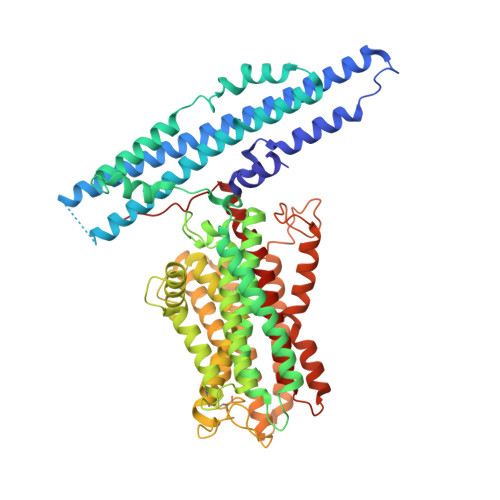KIDINS220 and InsP8 safeguard the stepwise regulation of phosphate exporter XPR1.
Wang, X., Bai, Z., Wallis, C., Wang, H., Han, Y., Jin, R., Lei, M., Yang, T., Gu, C., Jessen, H., Shears, S., Sun, Y., Corry, B., Zhang, Y.(2025) Mol Cell 85: 3209-3224.e8
- PubMed: 40858110
- DOI: https://doi.org/10.1016/j.molcel.2025.08.003
- Primary Citation of Related Structures:
9JXD, 9JXE, 9JXF, 9JXG, 9JXH, 9JXI, 9JXJ, 9JXK, 9JXL, 9JXM, 9JXN, 9JXO, 9JXP, 9JXQ, 9JXR - PubMed Abstract:
XPR1 is emerging as the only known inorganic phosphate (Pi) exporter in humans, critical for Pi homeostasis, with its activity stimulated by inositol pyrophosphate InsP8 and regulated by neuronal scaffold protein KIDINS220. Our structural studies reveal that InsP8 specifically activates XPR1 in a stepwise manner, involving profound SYG1/PHO/XPR1 (SPX) domain movements. Each XPR1 subunit functions with four gating states, in which Pi permeates a constriction site via a "knock-kiss-kick" process. By contrast, KIDINS220 delicately stabilizes XPR1 in a closed conformation through multiple mechanisms, one of which involves trapping the XPR1 α1 helix-critical for InsP8 binding-within an interaction hub. InsP8 serves as a key to release KIDINS220's restraint, reinforcing a "key-to-locks" mechanism to safeguard the stepwise activation. Additionally, our study provides direct structural insights into XPR1-associated neuronal disorders and highlights the evolutionary conservation and divergence among XPR1 orthologs, offering a comprehensive understanding of Pi homeostasis across species.
- Interdisciplinary Research Center on Biology and Chemistry, Shanghai Institute of Organic Chemistry, Chinese Academy of Sciences, Shanghai 201210, China; Shanghai Key Laboratory of Aging Studies, Shanghai 201210, China.
Organizational Affiliation:

















